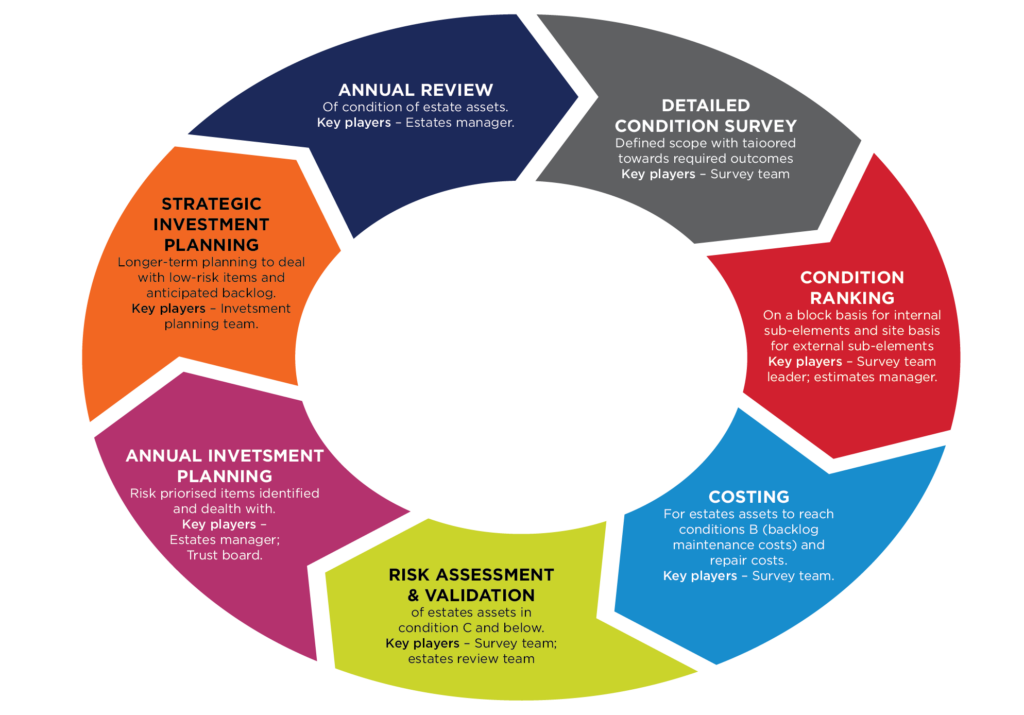Data is critical in informing the rationalisation of healthcare estates and enabling more sustainable outcomes and consequently many healthcare organisations are looking for a leaner and more efficient estate rationalisation strategy that effectively supports their organisation’s business activity.
With governments globally committing core funding and investment in healthcare in 2022 there is now more than ever a need for healthcare providers to understand the condition and ‘fit-for-purpose’ nature of their estates as well as the projected performance throughout the property lifecycle.
Today, to develop business cases into investment, healthcare estates managers need to rely on accurate bases of data. And here comes the rub – the most common theme we hear from healthcare professionals in the UK estates departments is the lack of confidence in their estate information with baseline data requiring significant interpretation to establish their current portfolio position.
Technology and the data process
The present state we find most healthcare providers are in is “data rich but information poor”. However, this is a short term situation with an opportunity in the long term to rebase asset information and drive for more effective data driven asset management solutions with clear insights and trends on portfolio performance.
The data contained within most property appraisals hasn’t changed but the way in which it is collected, presented and engaged has evolved.
Challenges for healthcare estate managers of not having clean, accurate and manageable data:
- No data or out-of-date data that no longer reflects the estate’s current condition will more likely result in difficulty in providing independent evidence-based reporting.
- Healthcare providers have access to data, but it exists in multiple locations and is often difficult to interpret and analyse and requires further work to connect the various pieces of information.
- Calculating backlog maintenance profiles and figures becomes a qualitative and subjective task for estate managers and results in a large body of work that is being undertaken by the organisation rather than relying on the analysis of a trusted, robust and accurate data set that defines the current position.
- Lack of internal governance around the strategy for asset management and maintenance of data held by the trust which often means the data doesn’t interface as well as it could with the capital programme or the estate strategy.
- Difficulty in ascertaining the relationship between calculating the erosion of backlog when undertaking capital projects.
Even when these challenges are recognised, it is often common that internal governance fails to record any changes on the asset register, that asset data is not maintained, impacting asset and equipment registers that indicate when equipment needs replacing or new equipment installed. Without a systematic way to start and keep data clean, there is no doubt that bad data will happen.
The Solutions: How to begin to gather data and what insights to look for
Unlocking the power of data for our estates and facilities requires a strategic approach and plan at the outset. The following should be addressed in first defining your data strategy:
Where are we now?
- What is the confidence level in existing data sources?
- How old is the data and when was the last validation exercise?
- How do we interact with our existing information?
- Is information stored in differing formats and media?
- What challenges do we have in creating management reports and setting capital budgets?
Where do we want to be?
- What reports do we need to provide?
- What is the industry best practice guidance?
- What information do we need?
- How will this interface with the overarching estate strategy, master planning or capital programme activities?
- What internal governance do we need to deploy to manage the data?
- How will the data be stored and interacted with?
- Is a Computer Aided Facilities Management (CAFM) system to be considered?
- At what velocity will we need reports?
- What volume of data do we need and how do we make sure it is the right data?
How do we get there?
Once you have answered the previous questions, a simple data collection strategy and brief with action plans and funding solutions is required to allow a brief to be created for potential procurement.
Selecting the right data resolution and volume will play an important role in the future analysis as well as have an impact on costs and programme. Although survey costs will be seen as a significant investment, it is always good to remember the alternatives of not undertaking a survey or conducting an incorrect survey present a far larger risk resulting in higher long term potential costs.

Based on a graph from the UK’s NHS estate code risk-based methodology
The Power of Data
Agile reporting on the property portfolio and not relying on anecdotal information will be beneficial in many ways to all stakeholders:
- It will bring an appraisal of each asset or building within the portfolio in a holistic way.
- Opportunities for intelligent and informed procurement where trends in material can be captured in a more strategic way and potentially procured under one contract.
- Maximising the remaining life existing assets by operating a condition and risk-based approach meaning you can de-risk your portfolio with target capital spend.
The future of data within hospital estates driving the Net Zero Agenda
Estates’ managers will also need to begin to consider the need for data in the drive for achieving their government’s healthcare targets and commitments to achieving net-zero emissions. For example, in the UK, the NHS’ Delivering a Net Zero National Health Service strategy outlines three key principles aligning digitalisation and data with their environmental ambitions:
- Our innovation: By ensuring the digital transformation agenda aligns with our ambition to be a net zero health service and implementing a net zero horizon scanning function to identify future pipeline innovations.
- Our hospitals: By supporting the construction of 40 new ‘net zero hospitals’ as part of the government’s Health Infrastructure Plan with a new Net Zero Carbon Hospital Standard.
- Our heating and lighting: By completing a £50 million LED lighting replacement programme, which, expanded across the entire NHS, would improve patient comfort, and save over £3 billion during the coming three decades.
Whatever the challenges faced by the healthcare sector across our different regions and geographies, be that coping with another wave of the pandemic or playing catch up with the backlog of existing treatment needed, the condition of our healthcare estates need to be monitored and assessed to allow estate managers to access the funds available. It will be data that acts as the key to unlock this investment, and play a larger and more significant part than ever in the estates’ strategy for every healthcare estate manager.
FURTHER INFORMATION:



